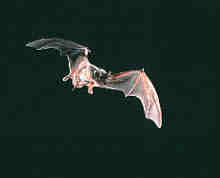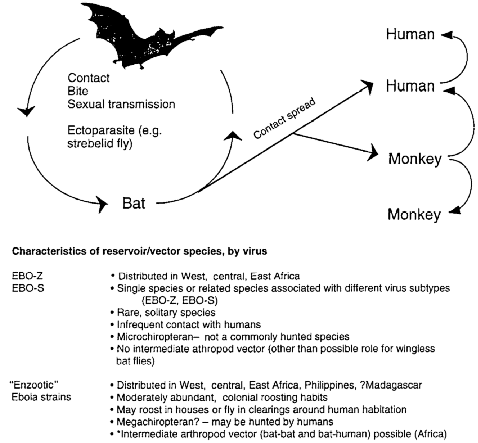Could Bats Be Ebola's Natural
Host/ Reservoir?

- Evidence Supporting Bats as the Vector
- Tadarida (mops) trevori were found in the roof of the Nzara Cotton
Factory during the 1976 outbreak of Ebola-Sudan. The index case and the
2 other primary cases worked in the Nzara Cotton Factory. Since these
three men did not live close to each other and did not have any social
contact outside of the Nzara Cotton Factory, the Nzara Cotton Factory
is considered to be the point of infection for these three men (1).
- The index case of the 1979 Ebola Sudan outbreak also worked at the Nzara
Cotton Factory (2).
- A study done at the National
Institute of Virology, South Africa has shown that Ebola can replicate
in fruit bats and other bats in the Tadarida genus, inoculated
with Ebola and can then pass through their stool.
- Infectious Ebola virions have been found in the stool of bats ("guano")
(4). The infectious guano could have transmitted Ebola to humans
or to another intermediate vector.
- Bats in Mount Elgon have been implicated in the transmission of Marburg
(a filovirus closely related to Ebola) on two separate occasions. However,
bats and guano collected from Mount Elgon have not tested positive for
Ebola (6).
 Image from Monath (7).
Image from Monath (7).

Image from Monath (7)
- Evidence Against Bats as the Vector
- Bats were not the only organisms found in the Cotton Factory; the three
men could have contracted EBO-S from another source.
- Ebola has never been found in bats captured during outbreaks. However,
the bats that were captured for testing were captured well after the start
of the outbreak. Bats that could have been infected with Ebola could have
died before the investigative team began collecting sample specimens.
The specific species that was found at the Nzara Cotton Factory, Tadarida
(mops) trevori were not captured and tested for the presence of Ebola
(3).
- Ebola-Zaire is highly pathogenic in other bats of the Tadarida
genus as well as in other species that are common in Africa (4).
If bats are the vector, they would most likely be an intermediate vector/host
because of Ebola's high pathogenecity in them.
- Unresolved Issues
- Numerous bats that were collected during the 1995 EBO-Z outbreak in
Zaire have not been tested and still remain in freezers at USAMRIID (5).
- Specimens for reservoir/vector analysis were captured significantly
after the beginning of the outbreak.
- The vector/host could be strain specific (a specific organism may only
be the vector/host for a specific strain of Ebola).
- When organisms are collected for analysis, only a few are collected.
There is a low probability that the specific representative organism is
going to have the agent even if the particular species is the vector/host.
References:
- WHO International Study Team. "Ebola haemorrhagic fever in Sudan, 1976."
Bulletin of the World Health Organization, 56 (2): 247-270
(1978).
- Baron, R.C. et al. "Ebola virus disease in southern Sudan: hospital
dissemination and intrafamilial spread." Bulletin of the World Health
Organization, 61 (6): 997-1003 (1983).
- Breman, J. et al. "A Search for Ebola Virus in Animals in the Democratic
Republic of the Congo and Cameroon: Ecologic, Virologic, and Serologic Surveys,
1979-1980." Journal of Infectious Diseases. 179(Suppl 1):S139-47
(1999).
- Swanepoel,
R. et al. "Experimental Inoculation of Plants and Animals with Ebola Virus."
Emerginging Infectious Diseases, 2 (4). 321-25. October-December
1996.
- Anderson, Art. Personal communication.
- Peters, C.J. Virus Hunter: Thirty Years of Battling Hot Viruses Around
the World. New York: Doubleday. 1997.
- Monath, Thomas. "Ecology of Marburg and Ebola Viruses: Speculations
and Directions for Future Research." Journal of Infectious Diseases.
1999;179(Suppl 1):S127-38.
©1999 Tara Waterman



